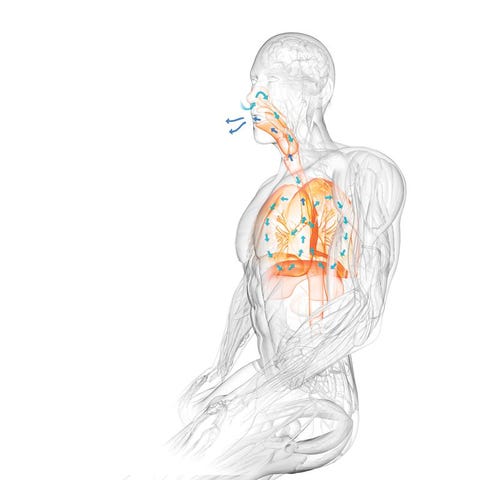Breathe the Right Way to Maximize Your Gains
Brandon Lilly is one of the strongest men on the planet, an elite powerlifter who’s squatted 843 pounds.
But then a knee injury sidelined him in 2014. “I had to look at myself in the mirror,” he says. “The whole reason I got into powerlifting was to look better, feel better, and get stronger. The only thing that had improved was my strength.” At 345 pounds, Lilly couldn’t walkthrough a shopping mall without getting winded. “I wouldn’t have been able to run to save my own life,” he says.
As he rehabbed his knee, Lilly found Belisa Vranich, Psy.D., a clinical psychologist who is also a breathing coach to celebrities, athletes, and military personnel. It’s not news that deep breathing confers many benefits. But like Lilly, many overlook its gym advantages. Lilly learned he was a “vertical breather,” doing the equivalent of a shrug every time he inhaled. By not using his diaphragm, Lilly’s breathing was less than optimal.
Vranich taught Lilly to expand and contract his midsection, better oxygenating his muscles and organs and creating a more stable base for his lifts. The results came right away. Before his first lesson he’d be gassed after eight squats with 315 pounds. After? He did 23 straight reps. Life outside the gym improved too. Once lethargic, Lilly now feels more energetic. But all he’s running on is air.
How to Catch Your Breath

Sinelab
The Inhale
Do It Better: To ensure that your breath fills your belly first, watch your shoulders; they should barely move.
The Exhale
Do It Better: Push your lower back into a chair and blow out all the air that you possibly can.
The Diaphragm
Do It Better: Practice belly breathing by lying down with a light kettlebell on your stomach; push it up while inhaling.
Breathing for Strength and Power
For your heaviest lifts—sets of 5 or fewer reps—Vranich suggests these steps to both help you power through a set and refocus between each rep.

Men’s Health
Stop Sucking in Your Gut
Lift Your Balls
Brace Yourself
Breathing Between Intervals and Sets
Want to dominate your next CrossFit class? Finesse your breath between sets to expel carbon dioxide and take in oxygen as quickly as your body needs it.

+ISM
Let It Out
- When you’re winded, your instinct is to inhale harder. Your body really wants to exhale. Do so audibly a few times to minimize the air left in your lungs, and hold for 1 second before inhaling again.
Pull It In
- Once your lungs are empty, take a deep, diaphragmatic breath into your belly and sides. Do this two or three times. You should feel your-self breathing normally again and be ready to start the next round.
Practice Outside the Gym
- Train breathing muscles between workouts. Practice what Vranich calls exhale pulsations: Inhale gently through pursed lips; exhale forcefully, narrowing your body. Start with 25 reps; work up to 100.
Breathing for Recovery
Use this controlled hyperventilation technique, popular in the 1960s, to recover after or between workouts and to sleep better at night.

+ISM
Get Comfortable
- Lie on your back, one hand on your belly, one on your chest. Inhale through your mouth; fill your belly. Inhale until your chest is full. (Your hands are where they are to ensure you get the sequence right.)
Blow It Out
- Exhale forcefully, like you’re blowing out the candles on a cake. Your abs should feel wrung out. Repeat the process for 2 to 3 minutes. It should feel like a workout and maybe even leave you disoriented. That’s normal.
Relax
- Move your arms to your sides, palms up, and take diaphragmatic breaths through your nose. You may nod off. That’s okay; you’ve taken your body out of its “fight-or-flight” state, kickstarting recovery.
An Airy Tale
Inflate your pushup totals in just a few minutes (and right now).

PeopleImagesGetty Images
Dutchman Wim Hof is famous for his endurance stunts. He also has a breathing technique that can instantly increase your single-set pushup total. How does it work? Journalist Scott Carney, who visited Hof to learn his secrets, explains.
Source: Read Full Article


